Promoting Self-Management Skills for Type 2 Diabetes Mellitus in Older Adults
VerifiedAdded on 2022/11/25
|13
|3516
|370
AI Summary
This essay discusses the nursing assessment, management, and evaluation for Type 2 Diabetes Mellitus (T2DM) as a long-term condition (LTC) in older adults. It focuses on promoting self-management skills, including patient education, dietary management, BGL monitoring, and social participation.
Contribute Materials
Your contribution can guide someone’s learning journey. Share your
documents today.
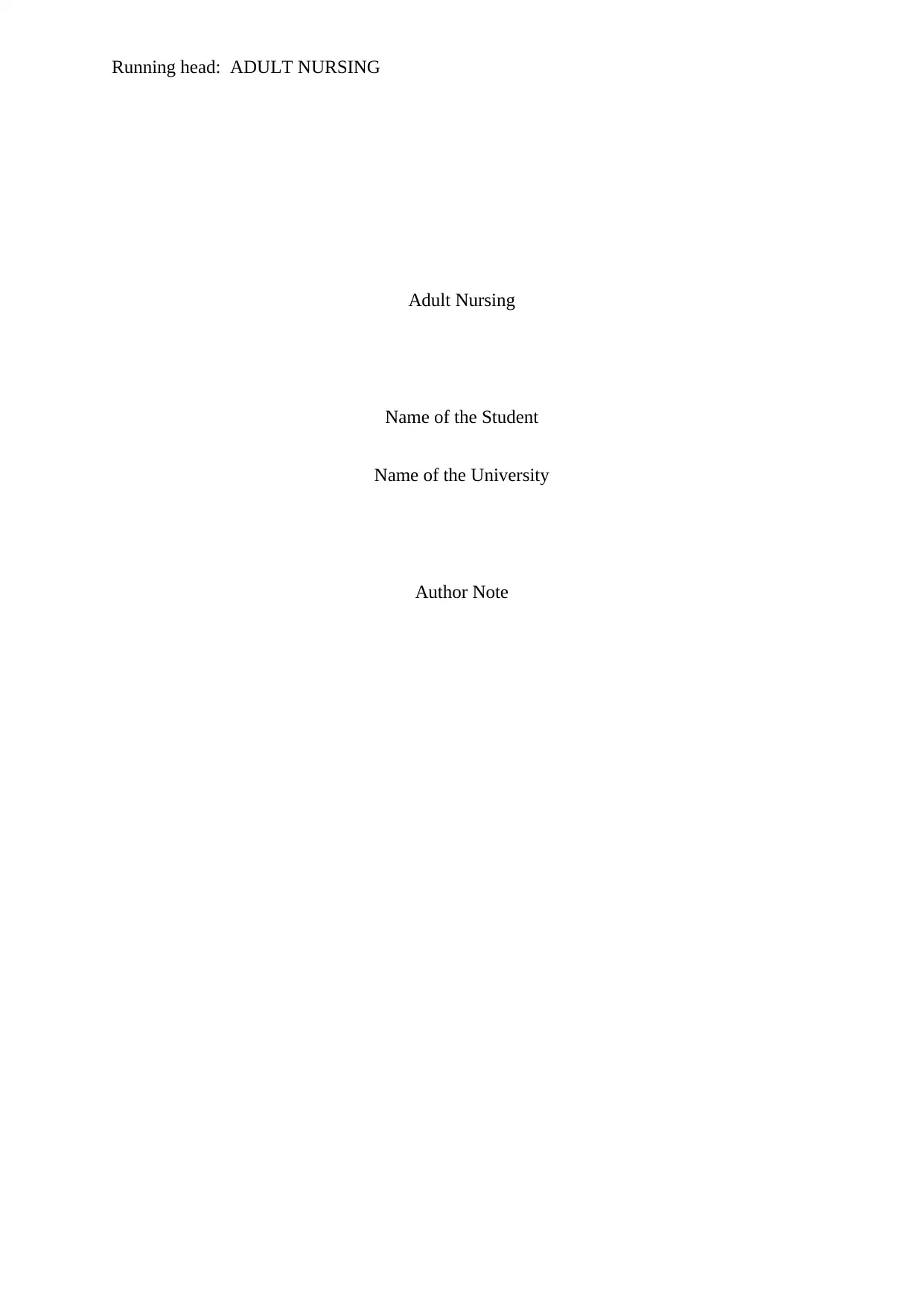
Running head: ADULT NURSING
Adult Nursing
Name of the Student
Name of the University
Author Note
Adult Nursing
Name of the Student
Name of the University
Author Note
Secure Best Marks with AI Grader
Need help grading? Try our AI Grader for instant feedback on your assignments.
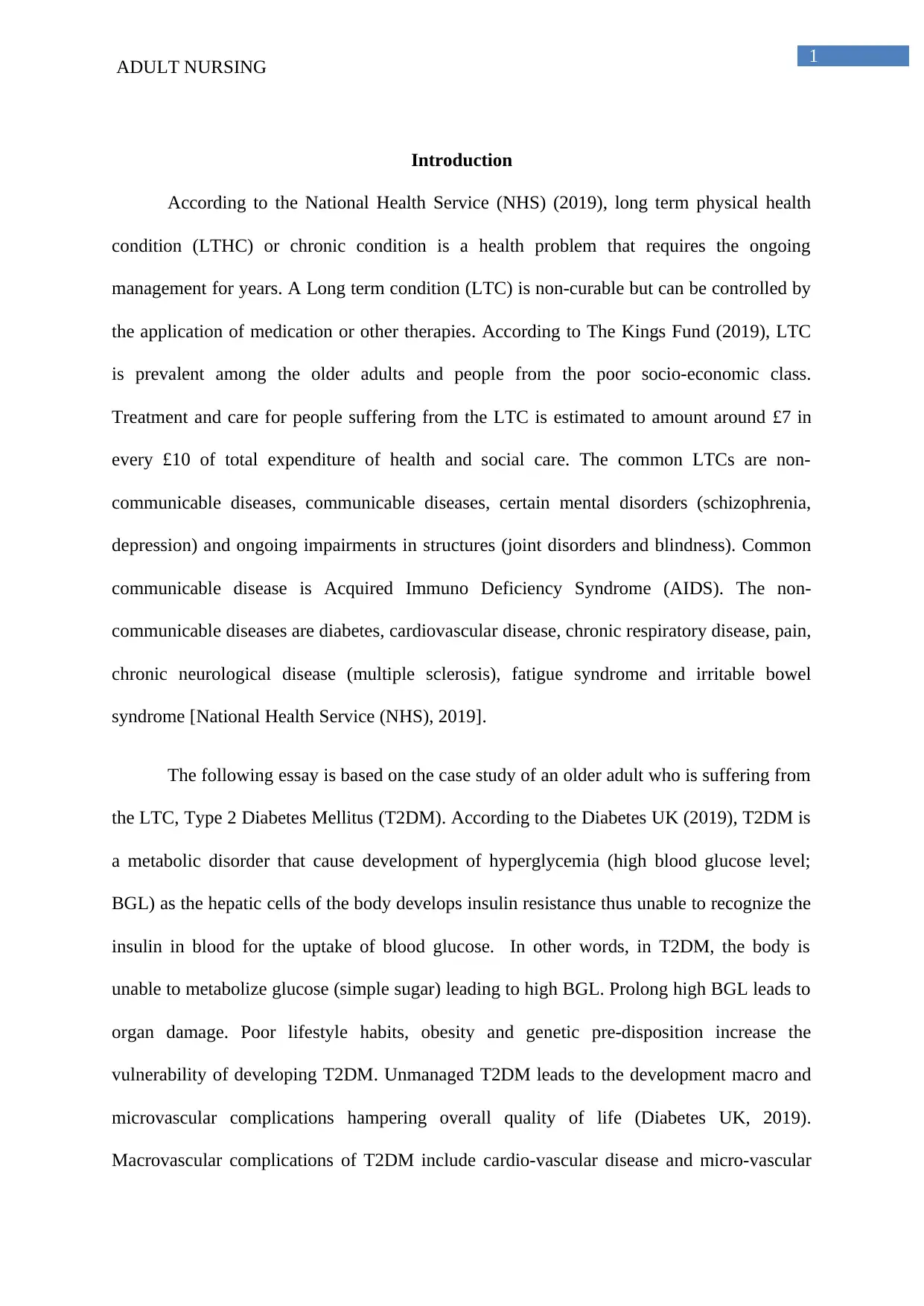
1
ADULT NURSING
Introduction
According to the National Health Service (NHS) (2019), long term physical health
condition (LTHC) or chronic condition is a health problem that requires the ongoing
management for years. A Long term condition (LTC) is non-curable but can be controlled by
the application of medication or other therapies. According to The Kings Fund (2019), LTC
is prevalent among the older adults and people from the poor socio-economic class.
Treatment and care for people suffering from the LTC is estimated to amount around £7 in
every £10 of total expenditure of health and social care. The common LTCs are non-
communicable diseases, communicable diseases, certain mental disorders (schizophrenia,
depression) and ongoing impairments in structures (joint disorders and blindness). Common
communicable disease is Acquired Immuno Deficiency Syndrome (AIDS). The non-
communicable diseases are diabetes, cardiovascular disease, chronic respiratory disease, pain,
chronic neurological disease (multiple sclerosis), fatigue syndrome and irritable bowel
syndrome [National Health Service (NHS), 2019].
The following essay is based on the case study of an older adult who is suffering from
the LTC, Type 2 Diabetes Mellitus (T2DM). According to the Diabetes UK (2019), T2DM is
a metabolic disorder that cause development of hyperglycemia (high blood glucose level;
BGL) as the hepatic cells of the body develops insulin resistance thus unable to recognize the
insulin in blood for the uptake of blood glucose. In other words, in T2DM, the body is
unable to metabolize glucose (simple sugar) leading to high BGL. Prolong high BGL leads to
organ damage. Poor lifestyle habits, obesity and genetic pre-disposition increase the
vulnerability of developing T2DM. Unmanaged T2DM leads to the development macro and
microvascular complications hampering overall quality of life (Diabetes UK, 2019).
Macrovascular complications of T2DM include cardio-vascular disease and micro-vascular
ADULT NURSING
Introduction
According to the National Health Service (NHS) (2019), long term physical health
condition (LTHC) or chronic condition is a health problem that requires the ongoing
management for years. A Long term condition (LTC) is non-curable but can be controlled by
the application of medication or other therapies. According to The Kings Fund (2019), LTC
is prevalent among the older adults and people from the poor socio-economic class.
Treatment and care for people suffering from the LTC is estimated to amount around £7 in
every £10 of total expenditure of health and social care. The common LTCs are non-
communicable diseases, communicable diseases, certain mental disorders (schizophrenia,
depression) and ongoing impairments in structures (joint disorders and blindness). Common
communicable disease is Acquired Immuno Deficiency Syndrome (AIDS). The non-
communicable diseases are diabetes, cardiovascular disease, chronic respiratory disease, pain,
chronic neurological disease (multiple sclerosis), fatigue syndrome and irritable bowel
syndrome [National Health Service (NHS), 2019].
The following essay is based on the case study of an older adult who is suffering from
the LTC, Type 2 Diabetes Mellitus (T2DM). According to the Diabetes UK (2019), T2DM is
a metabolic disorder that cause development of hyperglycemia (high blood glucose level;
BGL) as the hepatic cells of the body develops insulin resistance thus unable to recognize the
insulin in blood for the uptake of blood glucose. In other words, in T2DM, the body is
unable to metabolize glucose (simple sugar) leading to high BGL. Prolong high BGL leads to
organ damage. Poor lifestyle habits, obesity and genetic pre-disposition increase the
vulnerability of developing T2DM. Unmanaged T2DM leads to the development macro and
microvascular complications hampering overall quality of life (Diabetes UK, 2019).
Macrovascular complications of T2DM include cardio-vascular disease and micro-vascular
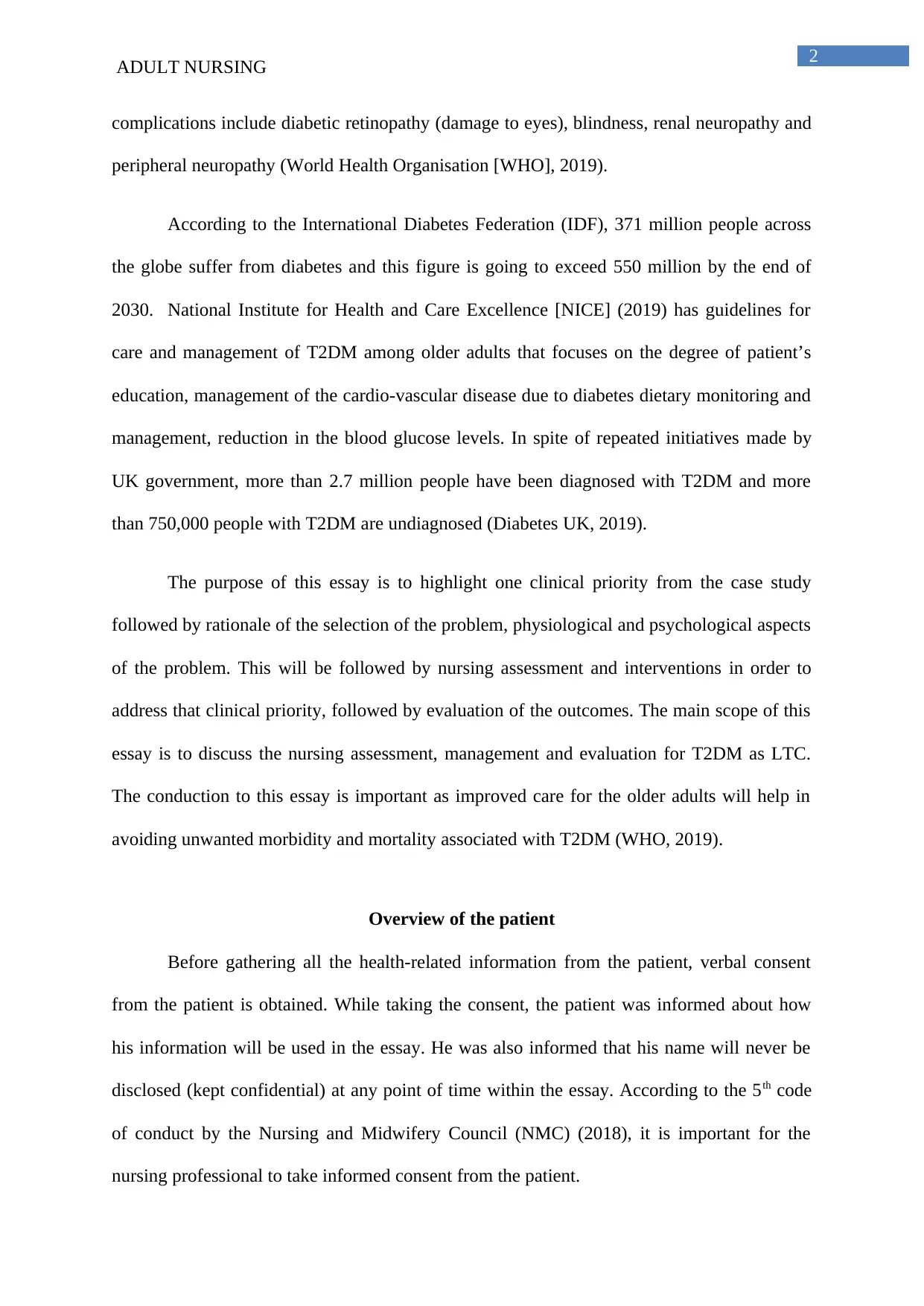
2
ADULT NURSING
complications include diabetic retinopathy (damage to eyes), blindness, renal neuropathy and
peripheral neuropathy (World Health Organisation [WHO], 2019).
According to the International Diabetes Federation (IDF), 371 million people across
the globe suffer from diabetes and this figure is going to exceed 550 million by the end of
2030. National Institute for Health and Care Excellence [NICE] (2019) has guidelines for
care and management of T2DM among older adults that focuses on the degree of patient’s
education, management of the cardio-vascular disease due to diabetes dietary monitoring and
management, reduction in the blood glucose levels. In spite of repeated initiatives made by
UK government, more than 2.7 million people have been diagnosed with T2DM and more
than 750,000 people with T2DM are undiagnosed (Diabetes UK, 2019).
The purpose of this essay is to highlight one clinical priority from the case study
followed by rationale of the selection of the problem, physiological and psychological aspects
of the problem. This will be followed by nursing assessment and interventions in order to
address that clinical priority, followed by evaluation of the outcomes. The main scope of this
essay is to discuss the nursing assessment, management and evaluation for T2DM as LTC.
The conduction to this essay is important as improved care for the older adults will help in
avoiding unwanted morbidity and mortality associated with T2DM (WHO, 2019).
Overview of the patient
Before gathering all the health-related information from the patient, verbal consent
from the patient is obtained. While taking the consent, the patient was informed about how
his information will be used in the essay. He was also informed that his name will never be
disclosed (kept confidential) at any point of time within the essay. According to the 5th code
of conduct by the Nursing and Midwifery Council (NMC) (2018), it is important for the
nursing professional to take informed consent from the patient.
ADULT NURSING
complications include diabetic retinopathy (damage to eyes), blindness, renal neuropathy and
peripheral neuropathy (World Health Organisation [WHO], 2019).
According to the International Diabetes Federation (IDF), 371 million people across
the globe suffer from diabetes and this figure is going to exceed 550 million by the end of
2030. National Institute for Health and Care Excellence [NICE] (2019) has guidelines for
care and management of T2DM among older adults that focuses on the degree of patient’s
education, management of the cardio-vascular disease due to diabetes dietary monitoring and
management, reduction in the blood glucose levels. In spite of repeated initiatives made by
UK government, more than 2.7 million people have been diagnosed with T2DM and more
than 750,000 people with T2DM are undiagnosed (Diabetes UK, 2019).
The purpose of this essay is to highlight one clinical priority from the case study
followed by rationale of the selection of the problem, physiological and psychological aspects
of the problem. This will be followed by nursing assessment and interventions in order to
address that clinical priority, followed by evaluation of the outcomes. The main scope of this
essay is to discuss the nursing assessment, management and evaluation for T2DM as LTC.
The conduction to this essay is important as improved care for the older adults will help in
avoiding unwanted morbidity and mortality associated with T2DM (WHO, 2019).
Overview of the patient
Before gathering all the health-related information from the patient, verbal consent
from the patient is obtained. While taking the consent, the patient was informed about how
his information will be used in the essay. He was also informed that his name will never be
disclosed (kept confidential) at any point of time within the essay. According to the 5th code
of conduct by the Nursing and Midwifery Council (NMC) (2018), it is important for the
nursing professional to take informed consent from the patient.
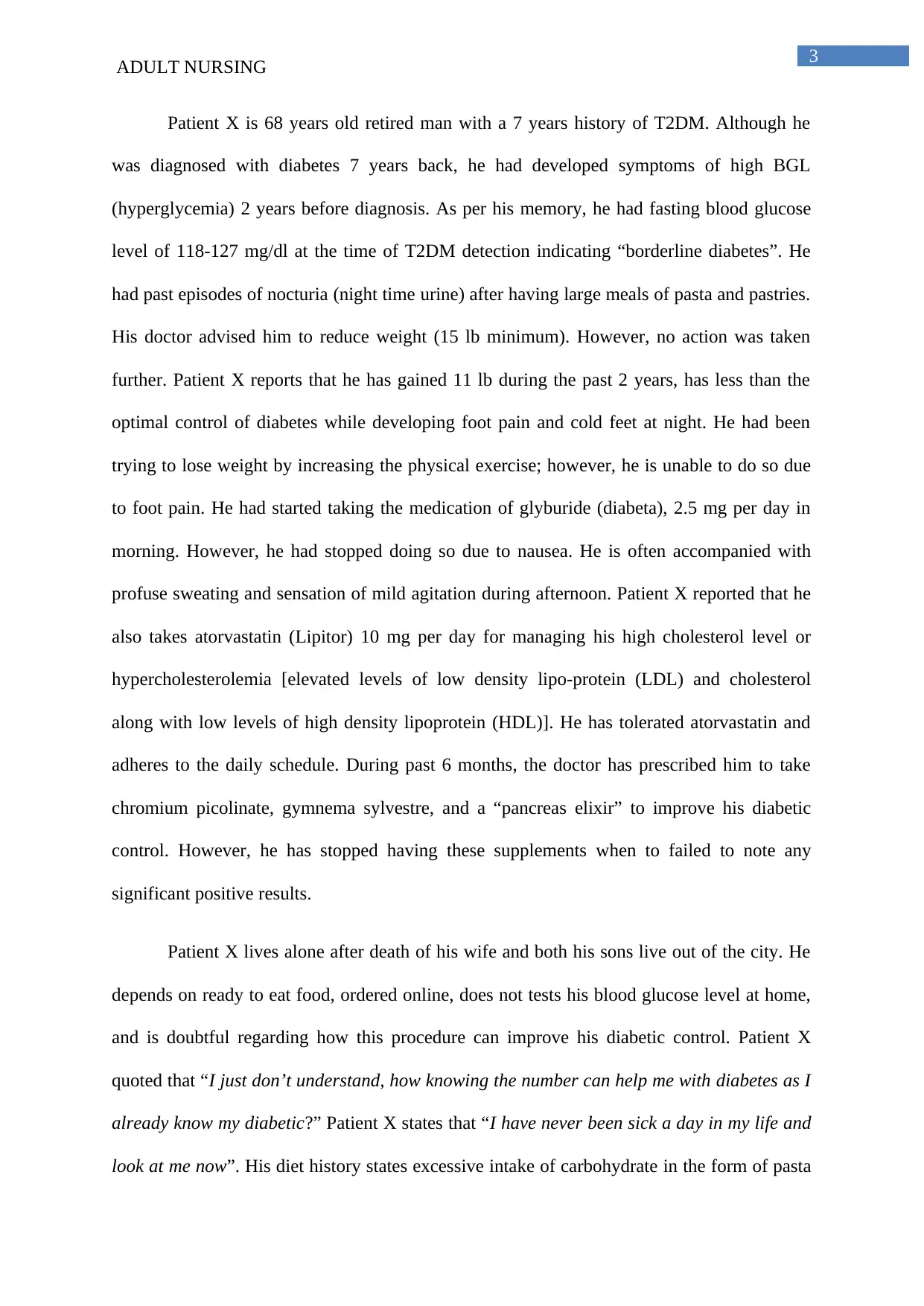
3
ADULT NURSING
Patient X is 68 years old retired man with a 7 years history of T2DM. Although he
was diagnosed with diabetes 7 years back, he had developed symptoms of high BGL
(hyperglycemia) 2 years before diagnosis. As per his memory, he had fasting blood glucose
level of 118-127 mg/dl at the time of T2DM detection indicating “borderline diabetes”. He
had past episodes of nocturia (night time urine) after having large meals of pasta and pastries.
His doctor advised him to reduce weight (15 lb minimum). However, no action was taken
further. Patient X reports that he has gained 11 lb during the past 2 years, has less than the
optimal control of diabetes while developing foot pain and cold feet at night. He had been
trying to lose weight by increasing the physical exercise; however, he is unable to do so due
to foot pain. He had started taking the medication of glyburide (diabeta), 2.5 mg per day in
morning. However, he had stopped doing so due to nausea. He is often accompanied with
profuse sweating and sensation of mild agitation during afternoon. Patient X reported that he
also takes atorvastatin (Lipitor) 10 mg per day for managing his high cholesterol level or
hypercholesterolemia [elevated levels of low density lipo-protein (LDL) and cholesterol
along with low levels of high density lipoprotein (HDL)]. He has tolerated atorvastatin and
adheres to the daily schedule. During past 6 months, the doctor has prescribed him to take
chromium picolinate, gymnema sylvestre, and a “pancreas elixir” to improve his diabetic
control. However, he has stopped having these supplements when to failed to note any
significant positive results.
Patient X lives alone after death of his wife and both his sons live out of the city. He
depends on ready to eat food, ordered online, does not tests his blood glucose level at home,
and is doubtful regarding how this procedure can improve his diabetic control. Patient X
quoted that “I just don’t understand, how knowing the number can help me with diabetes as I
already know my diabetic?” Patient X states that “I have never been sick a day in my life and
look at me now”. His diet history states excessive intake of carbohydrate in the form of pasta
ADULT NURSING
Patient X is 68 years old retired man with a 7 years history of T2DM. Although he
was diagnosed with diabetes 7 years back, he had developed symptoms of high BGL
(hyperglycemia) 2 years before diagnosis. As per his memory, he had fasting blood glucose
level of 118-127 mg/dl at the time of T2DM detection indicating “borderline diabetes”. He
had past episodes of nocturia (night time urine) after having large meals of pasta and pastries.
His doctor advised him to reduce weight (15 lb minimum). However, no action was taken
further. Patient X reports that he has gained 11 lb during the past 2 years, has less than the
optimal control of diabetes while developing foot pain and cold feet at night. He had been
trying to lose weight by increasing the physical exercise; however, he is unable to do so due
to foot pain. He had started taking the medication of glyburide (diabeta), 2.5 mg per day in
morning. However, he had stopped doing so due to nausea. He is often accompanied with
profuse sweating and sensation of mild agitation during afternoon. Patient X reported that he
also takes atorvastatin (Lipitor) 10 mg per day for managing his high cholesterol level or
hypercholesterolemia [elevated levels of low density lipo-protein (LDL) and cholesterol
along with low levels of high density lipoprotein (HDL)]. He has tolerated atorvastatin and
adheres to the daily schedule. During past 6 months, the doctor has prescribed him to take
chromium picolinate, gymnema sylvestre, and a “pancreas elixir” to improve his diabetic
control. However, he has stopped having these supplements when to failed to note any
significant positive results.
Patient X lives alone after death of his wife and both his sons live out of the city. He
depends on ready to eat food, ordered online, does not tests his blood glucose level at home,
and is doubtful regarding how this procedure can improve his diabetic control. Patient X
quoted that “I just don’t understand, how knowing the number can help me with diabetes as I
already know my diabetic?” Patient X states that “I have never been sick a day in my life and
look at me now”. His diet history states excessive intake of carbohydrate in the form of pasta
Secure Best Marks with AI Grader
Need help grading? Try our AI Grader for instant feedback on your assignments.
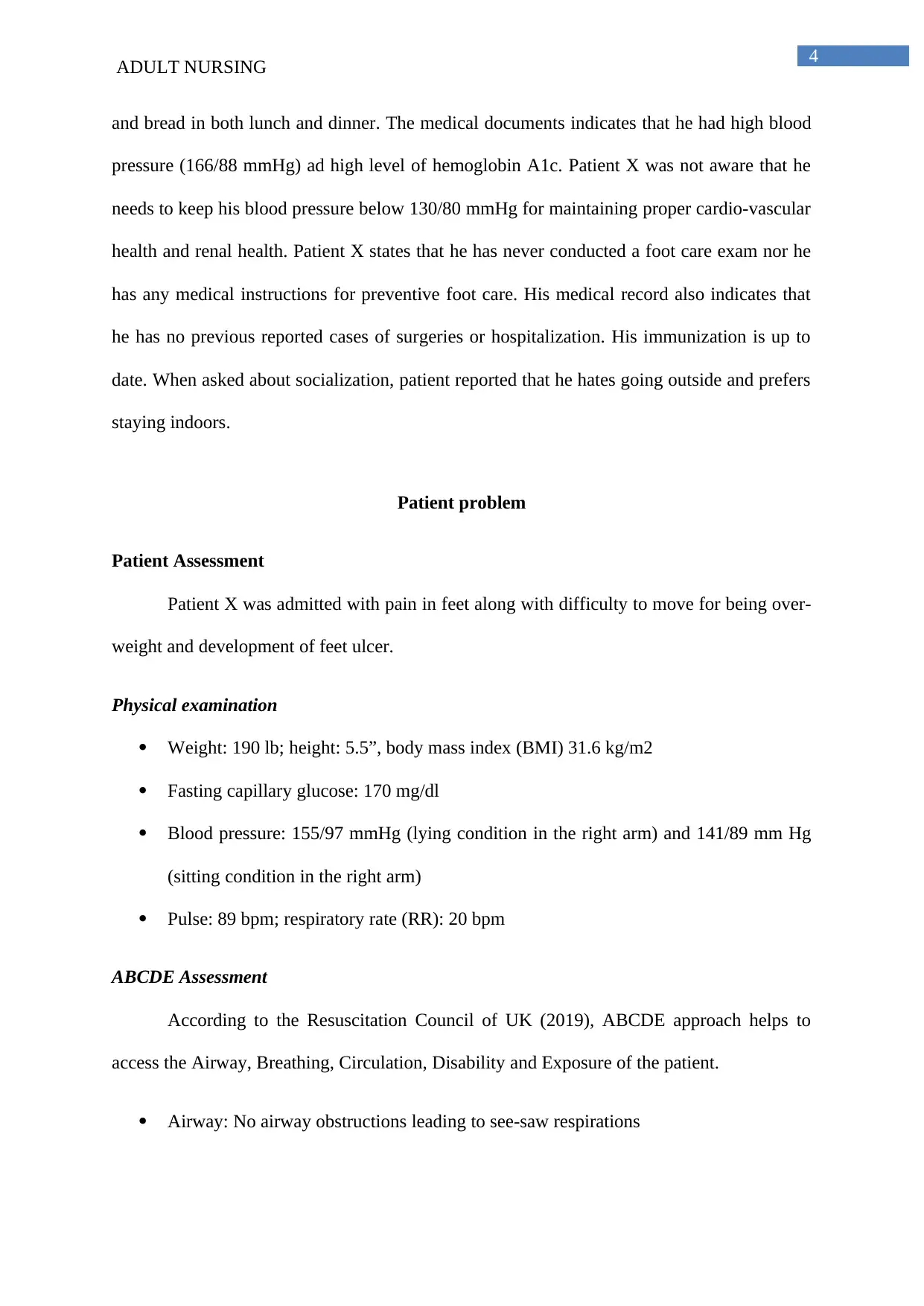
4
ADULT NURSING
and bread in both lunch and dinner. The medical documents indicates that he had high blood
pressure (166/88 mmHg) ad high level of hemoglobin A1c. Patient X was not aware that he
needs to keep his blood pressure below 130/80 mmHg for maintaining proper cardio-vascular
health and renal health. Patient X states that he has never conducted a foot care exam nor he
has any medical instructions for preventive foot care. His medical record also indicates that
he has no previous reported cases of surgeries or hospitalization. His immunization is up to
date. When asked about socialization, patient reported that he hates going outside and prefers
staying indoors.
Patient problem
Patient Assessment
Patient X was admitted with pain in feet along with difficulty to move for being over-
weight and development of feet ulcer.
Physical examination
Weight: 190 lb; height: 5.5”, body mass index (BMI) 31.6 kg/m2
Fasting capillary glucose: 170 mg/dl
Blood pressure: 155/97 mmHg (lying condition in the right arm) and 141/89 mm Hg
(sitting condition in the right arm)
Pulse: 89 bpm; respiratory rate (RR): 20 bpm
ABCDE Assessment
According to the Resuscitation Council of UK (2019), ABCDE approach helps to
access the Airway, Breathing, Circulation, Disability and Exposure of the patient.
Airway: No airway obstructions leading to see-saw respirations
ADULT NURSING
and bread in both lunch and dinner. The medical documents indicates that he had high blood
pressure (166/88 mmHg) ad high level of hemoglobin A1c. Patient X was not aware that he
needs to keep his blood pressure below 130/80 mmHg for maintaining proper cardio-vascular
health and renal health. Patient X states that he has never conducted a foot care exam nor he
has any medical instructions for preventive foot care. His medical record also indicates that
he has no previous reported cases of surgeries or hospitalization. His immunization is up to
date. When asked about socialization, patient reported that he hates going outside and prefers
staying indoors.
Patient problem
Patient Assessment
Patient X was admitted with pain in feet along with difficulty to move for being over-
weight and development of feet ulcer.
Physical examination
Weight: 190 lb; height: 5.5”, body mass index (BMI) 31.6 kg/m2
Fasting capillary glucose: 170 mg/dl
Blood pressure: 155/97 mmHg (lying condition in the right arm) and 141/89 mm Hg
(sitting condition in the right arm)
Pulse: 89 bpm; respiratory rate (RR): 20 bpm
ABCDE Assessment
According to the Resuscitation Council of UK (2019), ABCDE approach helps to
access the Airway, Breathing, Circulation, Disability and Exposure of the patient.
Airway: No airway obstructions leading to see-saw respirations
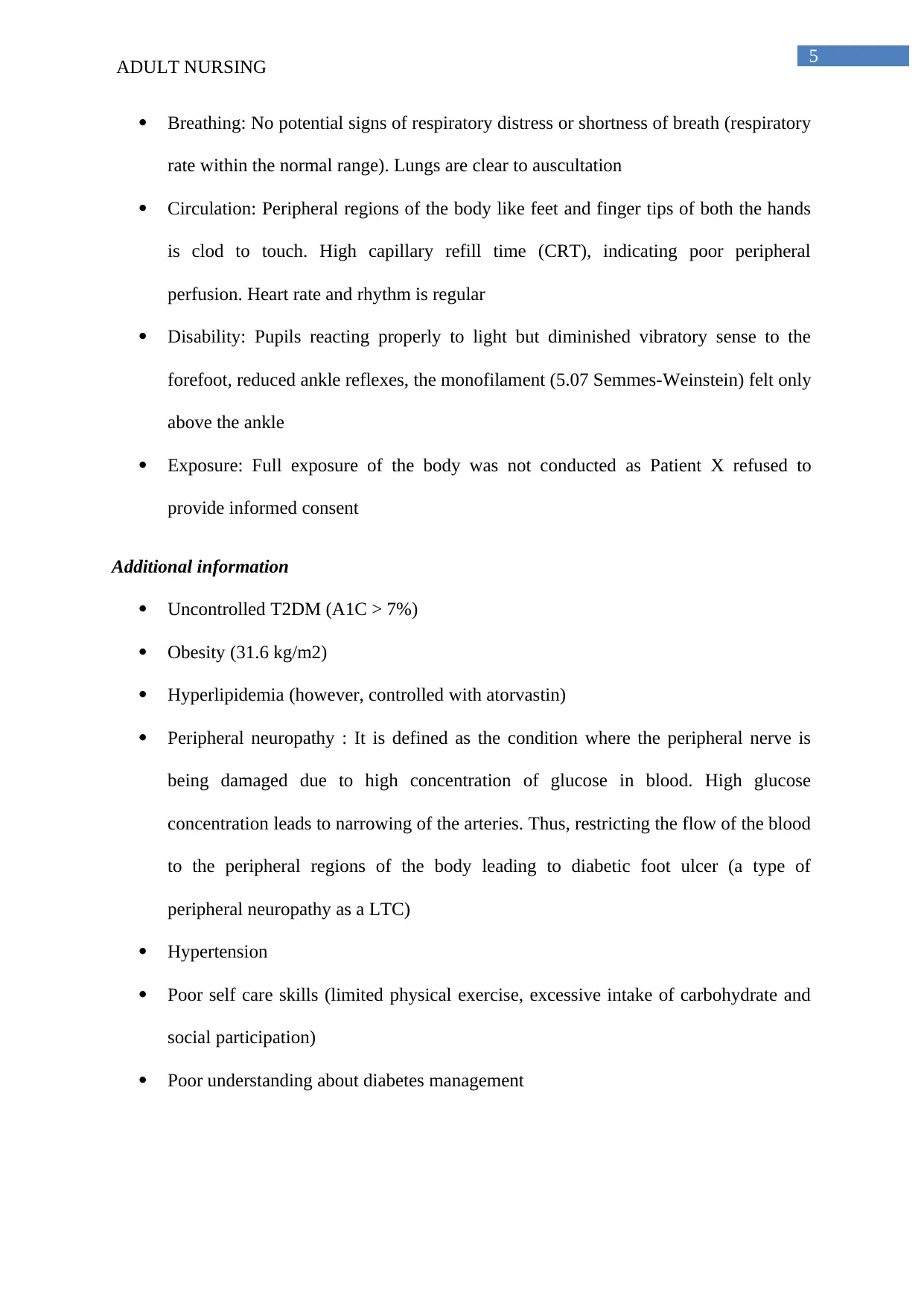
5
ADULT NURSING
Breathing: No potential signs of respiratory distress or shortness of breath (respiratory
rate within the normal range). Lungs are clear to auscultation
Circulation: Peripheral regions of the body like feet and finger tips of both the hands
is clod to touch. High capillary refill time (CRT), indicating poor peripheral
perfusion. Heart rate and rhythm is regular
Disability: Pupils reacting properly to light but diminished vibratory sense to the
forefoot, reduced ankle reflexes, the monofilament (5.07 Semmes-Weinstein) felt only
above the ankle
Exposure: Full exposure of the body was not conducted as Patient X refused to
provide informed consent
Additional information
Uncontrolled T2DM (A1C > 7%)
Obesity (31.6 kg/m2)
Hyperlipidemia (however, controlled with atorvastin)
Peripheral neuropathy : It is defined as the condition where the peripheral nerve is
being damaged due to high concentration of glucose in blood. High glucose
concentration leads to narrowing of the arteries. Thus, restricting the flow of the blood
to the peripheral regions of the body leading to diabetic foot ulcer (a type of
peripheral neuropathy as a LTC)
Hypertension
Poor self care skills (limited physical exercise, excessive intake of carbohydrate and
social participation)
Poor understanding about diabetes management
ADULT NURSING
Breathing: No potential signs of respiratory distress or shortness of breath (respiratory
rate within the normal range). Lungs are clear to auscultation
Circulation: Peripheral regions of the body like feet and finger tips of both the hands
is clod to touch. High capillary refill time (CRT), indicating poor peripheral
perfusion. Heart rate and rhythm is regular
Disability: Pupils reacting properly to light but diminished vibratory sense to the
forefoot, reduced ankle reflexes, the monofilament (5.07 Semmes-Weinstein) felt only
above the ankle
Exposure: Full exposure of the body was not conducted as Patient X refused to
provide informed consent
Additional information
Uncontrolled T2DM (A1C > 7%)
Obesity (31.6 kg/m2)
Hyperlipidemia (however, controlled with atorvastin)
Peripheral neuropathy : It is defined as the condition where the peripheral nerve is
being damaged due to high concentration of glucose in blood. High glucose
concentration leads to narrowing of the arteries. Thus, restricting the flow of the blood
to the peripheral regions of the body leading to diabetic foot ulcer (a type of
peripheral neuropathy as a LTC)
Hypertension
Poor self care skills (limited physical exercise, excessive intake of carbohydrate and
social participation)
Poor understanding about diabetes management
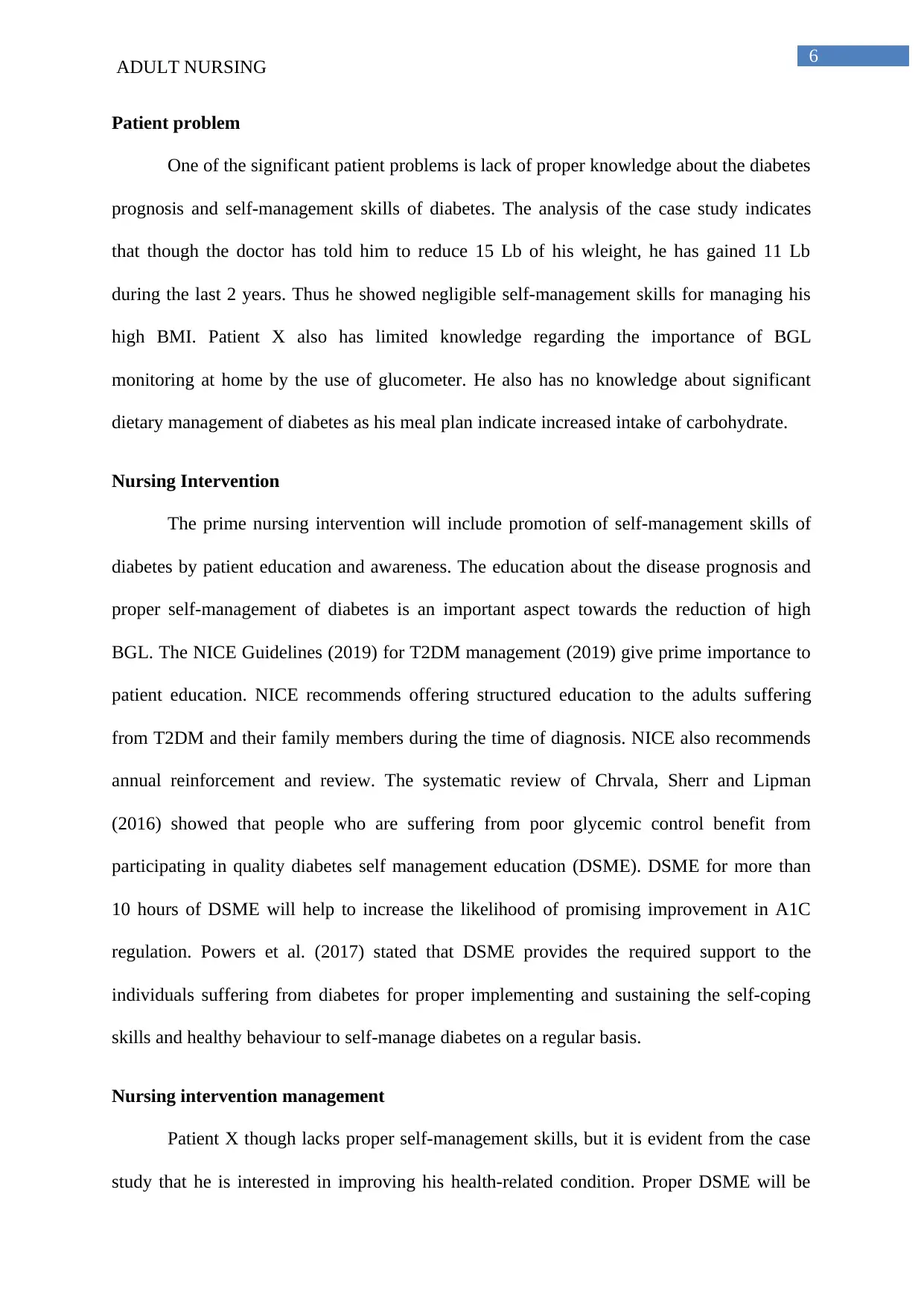
6
ADULT NURSING
Patient problem
One of the significant patient problems is lack of proper knowledge about the diabetes
prognosis and self-management skills of diabetes. The analysis of the case study indicates
that though the doctor has told him to reduce 15 Lb of his wleight, he has gained 11 Lb
during the last 2 years. Thus he showed negligible self-management skills for managing his
high BMI. Patient X also has limited knowledge regarding the importance of BGL
monitoring at home by the use of glucometer. He also has no knowledge about significant
dietary management of diabetes as his meal plan indicate increased intake of carbohydrate.
Nursing Intervention
The prime nursing intervention will include promotion of self-management skills of
diabetes by patient education and awareness. The education about the disease prognosis and
proper self-management of diabetes is an important aspect towards the reduction of high
BGL. The NICE Guidelines (2019) for T2DM management (2019) give prime importance to
patient education. NICE recommends offering structured education to the adults suffering
from T2DM and their family members during the time of diagnosis. NICE also recommends
annual reinforcement and review. The systematic review of Chrvala, Sherr and Lipman
(2016) showed that people who are suffering from poor glycemic control benefit from
participating in quality diabetes self management education (DSME). DSME for more than
10 hours of DSME will help to increase the likelihood of promising improvement in A1C
regulation. Powers et al. (2017) stated that DSME provides the required support to the
individuals suffering from diabetes for proper implementing and sustaining the self-coping
skills and healthy behaviour to self-manage diabetes on a regular basis.
Nursing intervention management
Patient X though lacks proper self-management skills, but it is evident from the case
study that he is interested in improving his health-related condition. Proper DSME will be
ADULT NURSING
Patient problem
One of the significant patient problems is lack of proper knowledge about the diabetes
prognosis and self-management skills of diabetes. The analysis of the case study indicates
that though the doctor has told him to reduce 15 Lb of his wleight, he has gained 11 Lb
during the last 2 years. Thus he showed negligible self-management skills for managing his
high BMI. Patient X also has limited knowledge regarding the importance of BGL
monitoring at home by the use of glucometer. He also has no knowledge about significant
dietary management of diabetes as his meal plan indicate increased intake of carbohydrate.
Nursing Intervention
The prime nursing intervention will include promotion of self-management skills of
diabetes by patient education and awareness. The education about the disease prognosis and
proper self-management of diabetes is an important aspect towards the reduction of high
BGL. The NICE Guidelines (2019) for T2DM management (2019) give prime importance to
patient education. NICE recommends offering structured education to the adults suffering
from T2DM and their family members during the time of diagnosis. NICE also recommends
annual reinforcement and review. The systematic review of Chrvala, Sherr and Lipman
(2016) showed that people who are suffering from poor glycemic control benefit from
participating in quality diabetes self management education (DSME). DSME for more than
10 hours of DSME will help to increase the likelihood of promising improvement in A1C
regulation. Powers et al. (2017) stated that DSME provides the required support to the
individuals suffering from diabetes for proper implementing and sustaining the self-coping
skills and healthy behaviour to self-manage diabetes on a regular basis.
Nursing intervention management
Patient X though lacks proper self-management skills, but it is evident from the case
study that he is interested in improving his health-related condition. Proper DSME will be
Paraphrase This Document
Need a fresh take? Get an instant paraphrase of this document with our AI Paraphraser
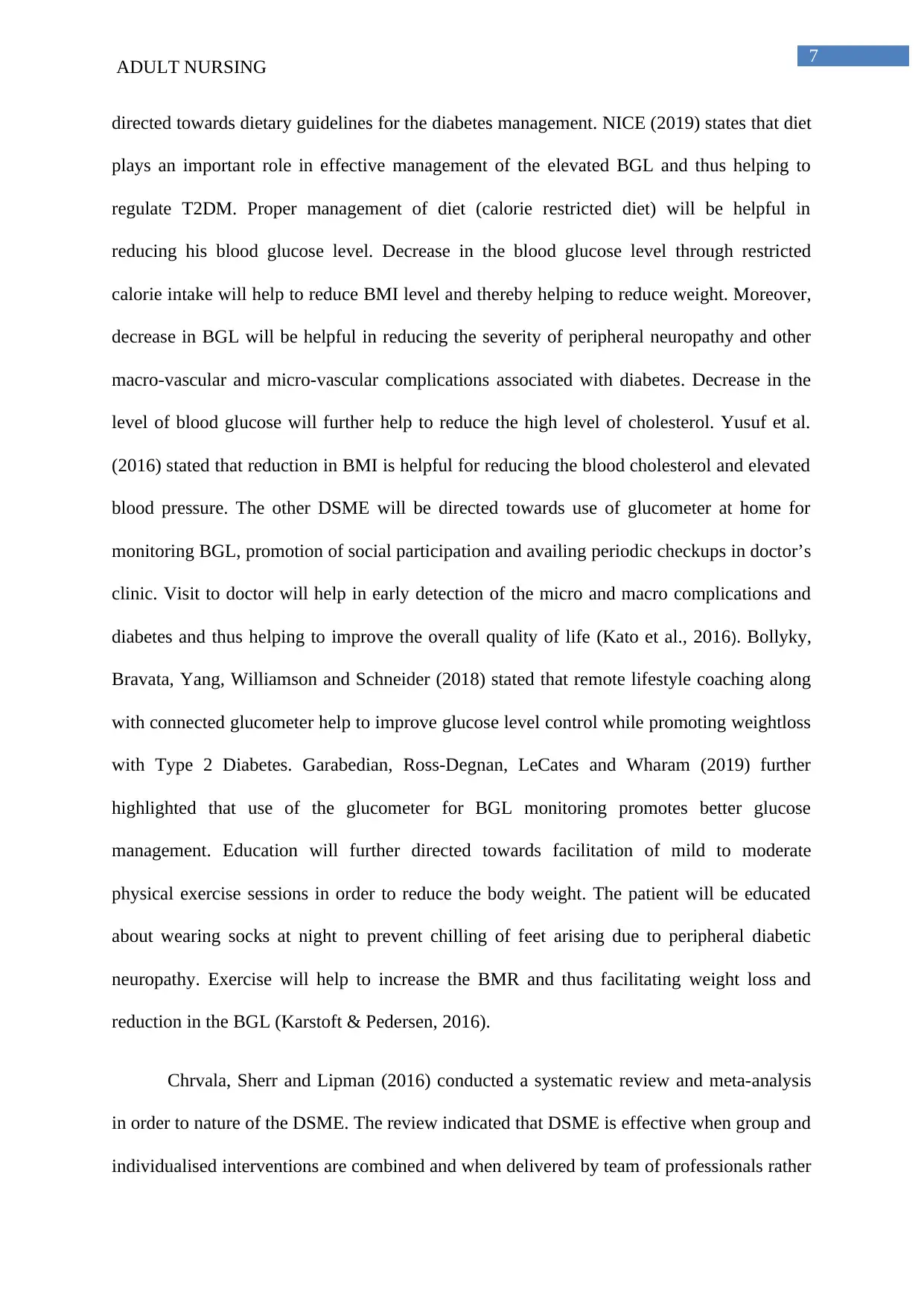
7
ADULT NURSING
directed towards dietary guidelines for the diabetes management. NICE (2019) states that diet
plays an important role in effective management of the elevated BGL and thus helping to
regulate T2DM. Proper management of diet (calorie restricted diet) will be helpful in
reducing his blood glucose level. Decrease in the blood glucose level through restricted
calorie intake will help to reduce BMI level and thereby helping to reduce weight. Moreover,
decrease in BGL will be helpful in reducing the severity of peripheral neuropathy and other
macro-vascular and micro-vascular complications associated with diabetes. Decrease in the
level of blood glucose will further help to reduce the high level of cholesterol. Yusuf et al.
(2016) stated that reduction in BMI is helpful for reducing the blood cholesterol and elevated
blood pressure. The other DSME will be directed towards use of glucometer at home for
monitoring BGL, promotion of social participation and availing periodic checkups in doctor’s
clinic. Visit to doctor will help in early detection of the micro and macro complications and
diabetes and thus helping to improve the overall quality of life (Kato et al., 2016). Bollyky,
Bravata, Yang, Williamson and Schneider (2018) stated that remote lifestyle coaching along
with connected glucometer help to improve glucose level control while promoting weightloss
with Type 2 Diabetes. Garabedian, Ross-Degnan, LeCates and Wharam (2019) further
highlighted that use of the glucometer for BGL monitoring promotes better glucose
management. Education will further directed towards facilitation of mild to moderate
physical exercise sessions in order to reduce the body weight. The patient will be educated
about wearing socks at night to prevent chilling of feet arising due to peripheral diabetic
neuropathy. Exercise will help to increase the BMR and thus facilitating weight loss and
reduction in the BGL (Karstoft & Pedersen, 2016).
Chrvala, Sherr and Lipman (2016) conducted a systematic review and meta-analysis
in order to nature of the DSME. The review indicated that DSME is effective when group and
individualised interventions are combined and when delivered by team of professionals rather
ADULT NURSING
directed towards dietary guidelines for the diabetes management. NICE (2019) states that diet
plays an important role in effective management of the elevated BGL and thus helping to
regulate T2DM. Proper management of diet (calorie restricted diet) will be helpful in
reducing his blood glucose level. Decrease in the blood glucose level through restricted
calorie intake will help to reduce BMI level and thereby helping to reduce weight. Moreover,
decrease in BGL will be helpful in reducing the severity of peripheral neuropathy and other
macro-vascular and micro-vascular complications associated with diabetes. Decrease in the
level of blood glucose will further help to reduce the high level of cholesterol. Yusuf et al.
(2016) stated that reduction in BMI is helpful for reducing the blood cholesterol and elevated
blood pressure. The other DSME will be directed towards use of glucometer at home for
monitoring BGL, promotion of social participation and availing periodic checkups in doctor’s
clinic. Visit to doctor will help in early detection of the micro and macro complications and
diabetes and thus helping to improve the overall quality of life (Kato et al., 2016). Bollyky,
Bravata, Yang, Williamson and Schneider (2018) stated that remote lifestyle coaching along
with connected glucometer help to improve glucose level control while promoting weightloss
with Type 2 Diabetes. Garabedian, Ross-Degnan, LeCates and Wharam (2019) further
highlighted that use of the glucometer for BGL monitoring promotes better glucose
management. Education will further directed towards facilitation of mild to moderate
physical exercise sessions in order to reduce the body weight. The patient will be educated
about wearing socks at night to prevent chilling of feet arising due to peripheral diabetic
neuropathy. Exercise will help to increase the BMR and thus facilitating weight loss and
reduction in the BGL (Karstoft & Pedersen, 2016).
Chrvala, Sherr and Lipman (2016) conducted a systematic review and meta-analysis
in order to nature of the DSME. The review indicated that DSME is effective when group and
individualised interventions are combined and when delivered by team of professionals rather
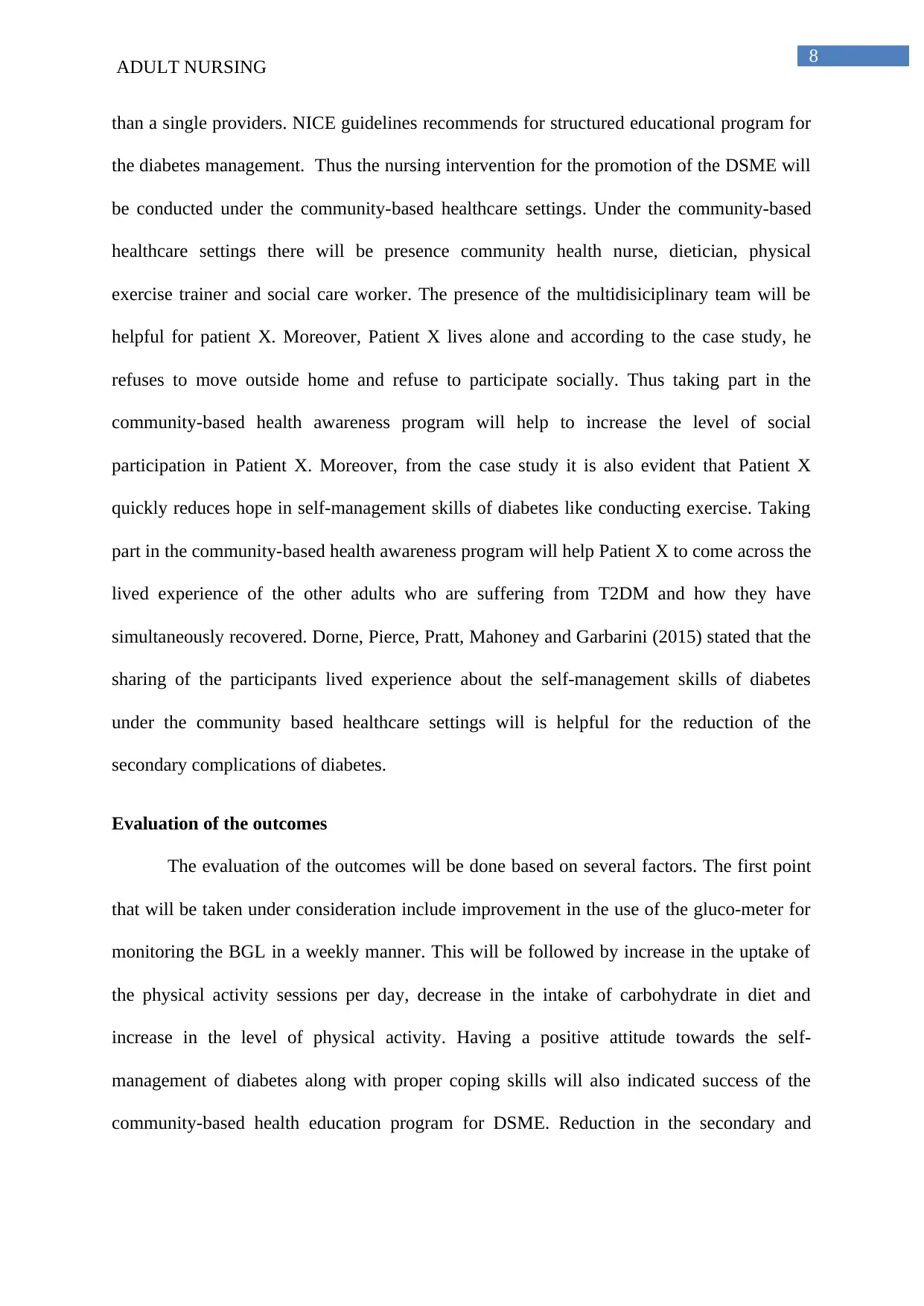
8
ADULT NURSING
than a single providers. NICE guidelines recommends for structured educational program for
the diabetes management. Thus the nursing intervention for the promotion of the DSME will
be conducted under the community-based healthcare settings. Under the community-based
healthcare settings there will be presence community health nurse, dietician, physical
exercise trainer and social care worker. The presence of the multidisiciplinary team will be
helpful for patient X. Moreover, Patient X lives alone and according to the case study, he
refuses to move outside home and refuse to participate socially. Thus taking part in the
community-based health awareness program will help to increase the level of social
participation in Patient X. Moreover, from the case study it is also evident that Patient X
quickly reduces hope in self-management skills of diabetes like conducting exercise. Taking
part in the community-based health awareness program will help Patient X to come across the
lived experience of the other adults who are suffering from T2DM and how they have
simultaneously recovered. Dorne, Pierce, Pratt, Mahoney and Garbarini (2015) stated that the
sharing of the participants lived experience about the self-management skills of diabetes
under the community based healthcare settings will is helpful for the reduction of the
secondary complications of diabetes.
Evaluation of the outcomes
The evaluation of the outcomes will be done based on several factors. The first point
that will be taken under consideration include improvement in the use of the gluco-meter for
monitoring the BGL in a weekly manner. This will be followed by increase in the uptake of
the physical activity sessions per day, decrease in the intake of carbohydrate in diet and
increase in the level of physical activity. Having a positive attitude towards the self-
management of diabetes along with proper coping skills will also indicated success of the
community-based health education program for DSME. Reduction in the secondary and
ADULT NURSING
than a single providers. NICE guidelines recommends for structured educational program for
the diabetes management. Thus the nursing intervention for the promotion of the DSME will
be conducted under the community-based healthcare settings. Under the community-based
healthcare settings there will be presence community health nurse, dietician, physical
exercise trainer and social care worker. The presence of the multidisiciplinary team will be
helpful for patient X. Moreover, Patient X lives alone and according to the case study, he
refuses to move outside home and refuse to participate socially. Thus taking part in the
community-based health awareness program will help to increase the level of social
participation in Patient X. Moreover, from the case study it is also evident that Patient X
quickly reduces hope in self-management skills of diabetes like conducting exercise. Taking
part in the community-based health awareness program will help Patient X to come across the
lived experience of the other adults who are suffering from T2DM and how they have
simultaneously recovered. Dorne, Pierce, Pratt, Mahoney and Garbarini (2015) stated that the
sharing of the participants lived experience about the self-management skills of diabetes
under the community based healthcare settings will is helpful for the reduction of the
secondary complications of diabetes.
Evaluation of the outcomes
The evaluation of the outcomes will be done based on several factors. The first point
that will be taken under consideration include improvement in the use of the gluco-meter for
monitoring the BGL in a weekly manner. This will be followed by increase in the uptake of
the physical activity sessions per day, decrease in the intake of carbohydrate in diet and
increase in the level of physical activity. Having a positive attitude towards the self-
management of diabetes along with proper coping skills will also indicated success of the
community-based health education program for DSME. Reduction in the secondary and
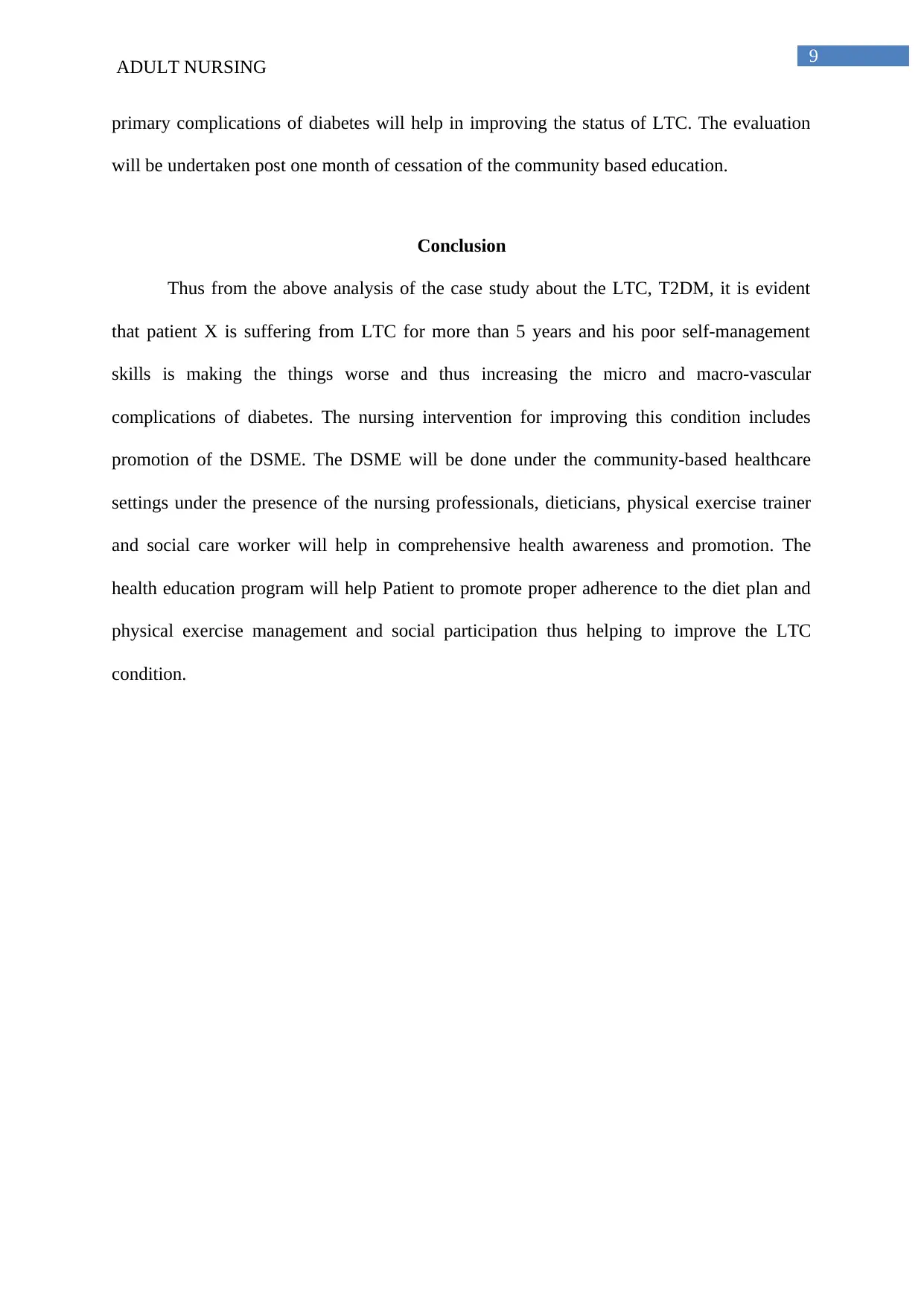
9
ADULT NURSING
primary complications of diabetes will help in improving the status of LTC. The evaluation
will be undertaken post one month of cessation of the community based education.
Conclusion
Thus from the above analysis of the case study about the LTC, T2DM, it is evident
that patient X is suffering from LTC for more than 5 years and his poor self-management
skills is making the things worse and thus increasing the micro and macro-vascular
complications of diabetes. The nursing intervention for improving this condition includes
promotion of the DSME. The DSME will be done under the community-based healthcare
settings under the presence of the nursing professionals, dieticians, physical exercise trainer
and social care worker will help in comprehensive health awareness and promotion. The
health education program will help Patient to promote proper adherence to the diet plan and
physical exercise management and social participation thus helping to improve the LTC
condition.
ADULT NURSING
primary complications of diabetes will help in improving the status of LTC. The evaluation
will be undertaken post one month of cessation of the community based education.
Conclusion
Thus from the above analysis of the case study about the LTC, T2DM, it is evident
that patient X is suffering from LTC for more than 5 years and his poor self-management
skills is making the things worse and thus increasing the micro and macro-vascular
complications of diabetes. The nursing intervention for improving this condition includes
promotion of the DSME. The DSME will be done under the community-based healthcare
settings under the presence of the nursing professionals, dieticians, physical exercise trainer
and social care worker will help in comprehensive health awareness and promotion. The
health education program will help Patient to promote proper adherence to the diet plan and
physical exercise management and social participation thus helping to improve the LTC
condition.
Secure Best Marks with AI Grader
Need help grading? Try our AI Grader for instant feedback on your assignments.
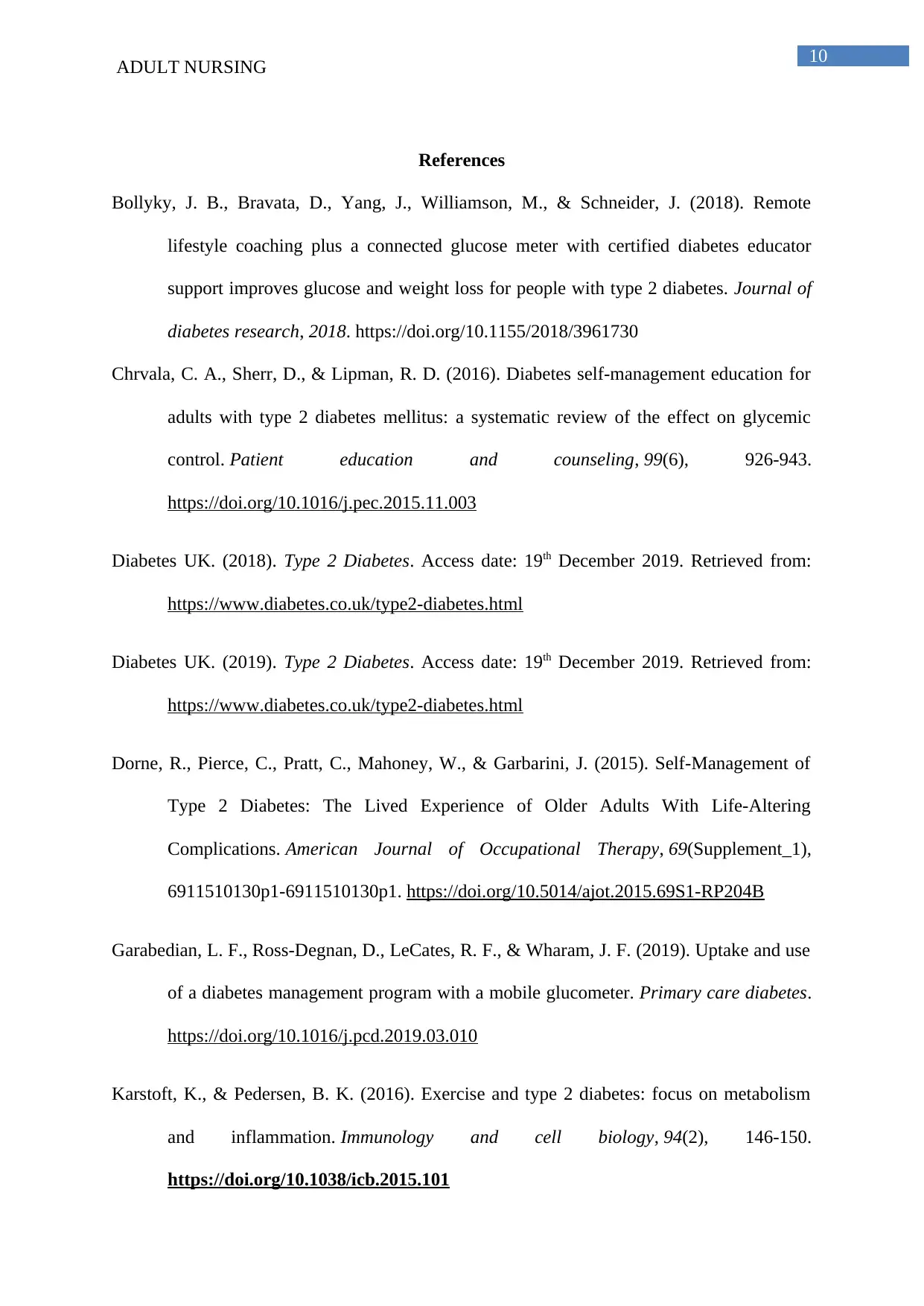
10
ADULT NURSING
References
Bollyky, J. B., Bravata, D., Yang, J., Williamson, M., & Schneider, J. (2018). Remote
lifestyle coaching plus a connected glucose meter with certified diabetes educator
support improves glucose and weight loss for people with type 2 diabetes. Journal of
diabetes research, 2018. https://doi.org/10.1155/2018/3961730
Chrvala, C. A., Sherr, D., & Lipman, R. D. (2016). Diabetes self-management education for
adults with type 2 diabetes mellitus: a systematic review of the effect on glycemic
control. Patient education and counseling, 99(6), 926-943.
https://doi.org/10.1016/j.pec.2015.11.003
Diabetes UK. (2018). Type 2 Diabetes. Access date: 19th December 2019. Retrieved from:
https://www.diabetes.co.uk/type2-diabetes.html
Diabetes UK. (2019). Type 2 Diabetes. Access date: 19th December 2019. Retrieved from:
https://www.diabetes.co.uk/type2-diabetes.html
Dorne, R., Pierce, C., Pratt, C., Mahoney, W., & Garbarini, J. (2015). Self-Management of
Type 2 Diabetes: The Lived Experience of Older Adults With Life-Altering
Complications. American Journal of Occupational Therapy, 69(Supplement_1),
6911510130p1-6911510130p1. https://doi.org/10.5014/ajot.2015.69S1-RP204B
Garabedian, L. F., Ross-Degnan, D., LeCates, R. F., & Wharam, J. F. (2019). Uptake and use
of a diabetes management program with a mobile glucometer. Primary care diabetes.
https://doi.org/10.1016/j.pcd.2019.03.010
Karstoft, K., & Pedersen, B. K. (2016). Exercise and type 2 diabetes: focus on metabolism
and inflammation. Immunology and cell biology, 94(2), 146-150.
https://doi.org/10.1038/icb.2015.101
ADULT NURSING
References
Bollyky, J. B., Bravata, D., Yang, J., Williamson, M., & Schneider, J. (2018). Remote
lifestyle coaching plus a connected glucose meter with certified diabetes educator
support improves glucose and weight loss for people with type 2 diabetes. Journal of
diabetes research, 2018. https://doi.org/10.1155/2018/3961730
Chrvala, C. A., Sherr, D., & Lipman, R. D. (2016). Diabetes self-management education for
adults with type 2 diabetes mellitus: a systematic review of the effect on glycemic
control. Patient education and counseling, 99(6), 926-943.
https://doi.org/10.1016/j.pec.2015.11.003
Diabetes UK. (2018). Type 2 Diabetes. Access date: 19th December 2019. Retrieved from:
https://www.diabetes.co.uk/type2-diabetes.html
Diabetes UK. (2019). Type 2 Diabetes. Access date: 19th December 2019. Retrieved from:
https://www.diabetes.co.uk/type2-diabetes.html
Dorne, R., Pierce, C., Pratt, C., Mahoney, W., & Garbarini, J. (2015). Self-Management of
Type 2 Diabetes: The Lived Experience of Older Adults With Life-Altering
Complications. American Journal of Occupational Therapy, 69(Supplement_1),
6911510130p1-6911510130p1. https://doi.org/10.5014/ajot.2015.69S1-RP204B
Garabedian, L. F., Ross-Degnan, D., LeCates, R. F., & Wharam, J. F. (2019). Uptake and use
of a diabetes management program with a mobile glucometer. Primary care diabetes.
https://doi.org/10.1016/j.pcd.2019.03.010
Karstoft, K., & Pedersen, B. K. (2016). Exercise and type 2 diabetes: focus on metabolism
and inflammation. Immunology and cell biology, 94(2), 146-150.
https://doi.org/10.1038/icb.2015.101
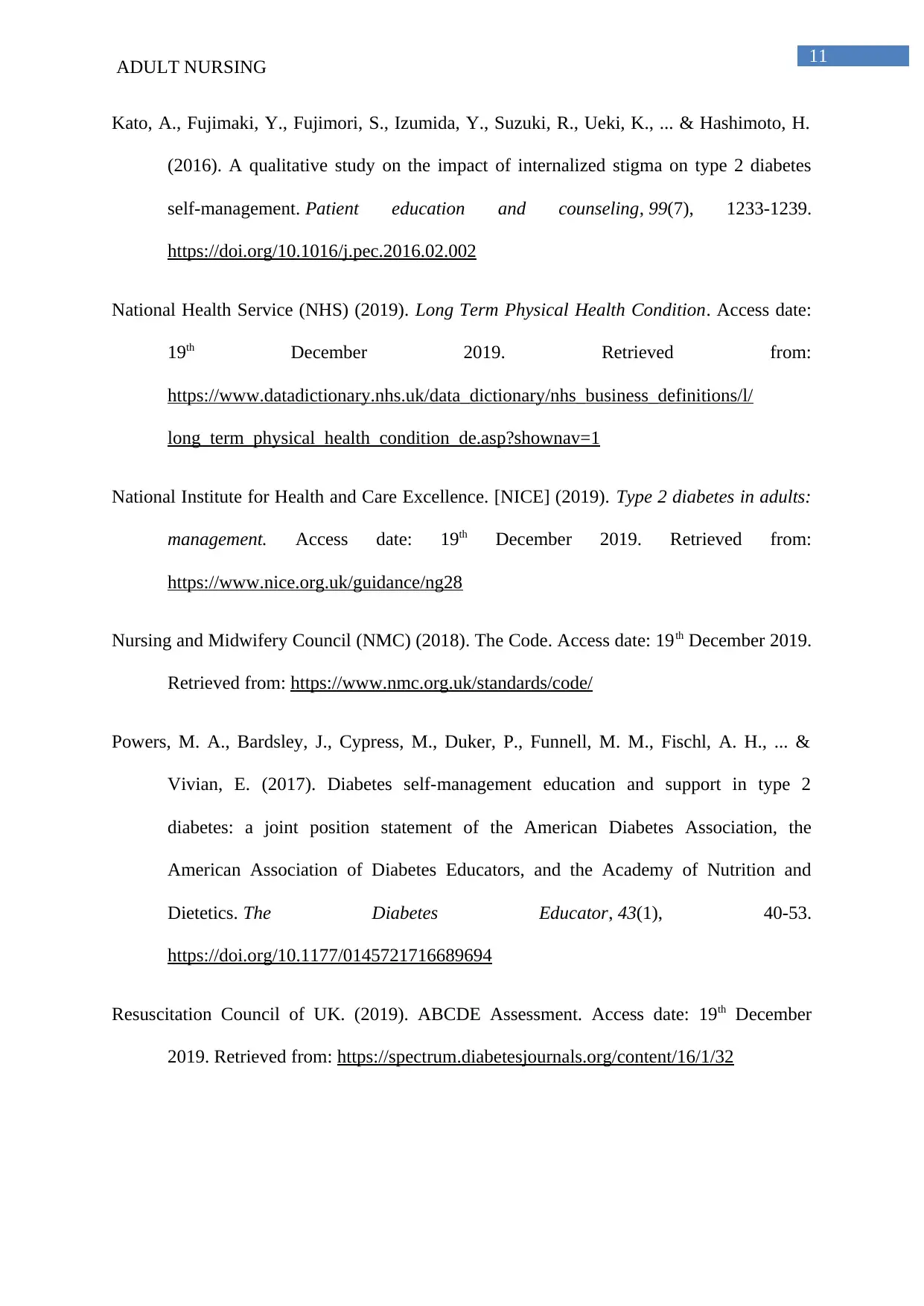
11
ADULT NURSING
Kato, A., Fujimaki, Y., Fujimori, S., Izumida, Y., Suzuki, R., Ueki, K., ... & Hashimoto, H.
(2016). A qualitative study on the impact of internalized stigma on type 2 diabetes
self-management. Patient education and counseling, 99(7), 1233-1239.
https://doi.org/10.1016/j.pec.2016.02.002
National Health Service (NHS) (2019). Long Term Physical Health Condition. Access date:
19th December 2019. Retrieved from:
https://www.datadictionary.nhs.uk/data_dictionary/nhs_business_definitions/l/
long_term_physical_health_condition_de.asp?shownav=1
National Institute for Health and Care Excellence. [NICE] (2019). Type 2 diabetes in adults:
management. Access date: 19th December 2019. Retrieved from:
https://www.nice.org.uk/guidance/ng28
Nursing and Midwifery Council (NMC) (2018). The Code. Access date: 19th December 2019.
Retrieved from: https://www.nmc.org.uk/standards/code/
Powers, M. A., Bardsley, J., Cypress, M., Duker, P., Funnell, M. M., Fischl, A. H., ... &
Vivian, E. (2017). Diabetes self-management education and support in type 2
diabetes: a joint position statement of the American Diabetes Association, the
American Association of Diabetes Educators, and the Academy of Nutrition and
Dietetics. The Diabetes Educator, 43(1), 40-53.
https://doi.org/10.1177/0145721716689694
Resuscitation Council of UK. (2019). ABCDE Assessment. Access date: 19th December
2019. Retrieved from: https://spectrum.diabetesjournals.org/content/16/1/32
ADULT NURSING
Kato, A., Fujimaki, Y., Fujimori, S., Izumida, Y., Suzuki, R., Ueki, K., ... & Hashimoto, H.
(2016). A qualitative study on the impact of internalized stigma on type 2 diabetes
self-management. Patient education and counseling, 99(7), 1233-1239.
https://doi.org/10.1016/j.pec.2016.02.002
National Health Service (NHS) (2019). Long Term Physical Health Condition. Access date:
19th December 2019. Retrieved from:
https://www.datadictionary.nhs.uk/data_dictionary/nhs_business_definitions/l/
long_term_physical_health_condition_de.asp?shownav=1
National Institute for Health and Care Excellence. [NICE] (2019). Type 2 diabetes in adults:
management. Access date: 19th December 2019. Retrieved from:
https://www.nice.org.uk/guidance/ng28
Nursing and Midwifery Council (NMC) (2018). The Code. Access date: 19th December 2019.
Retrieved from: https://www.nmc.org.uk/standards/code/
Powers, M. A., Bardsley, J., Cypress, M., Duker, P., Funnell, M. M., Fischl, A. H., ... &
Vivian, E. (2017). Diabetes self-management education and support in type 2
diabetes: a joint position statement of the American Diabetes Association, the
American Association of Diabetes Educators, and the Academy of Nutrition and
Dietetics. The Diabetes Educator, 43(1), 40-53.
https://doi.org/10.1177/0145721716689694
Resuscitation Council of UK. (2019). ABCDE Assessment. Access date: 19th December
2019. Retrieved from: https://spectrum.diabetesjournals.org/content/16/1/32

12
ADULT NURSING
The Kings Fund. (2019). Long-term conditions and multi-morbidity. Access date: 19th
December 2019. Retrieved from: https://www.kingsfund.org.uk/projects/time-think-
differently/trends-disease-and-disability-long-term-conditions-multi-morbidity
World Health Organisation (2019). About diabetes. Access date: 19th December 2019.
Retrieved from: https://www.who.int/diabetes/action_online/basics/en/index3.html
Yusuf, S., Bosch, J., Dagenais, G., Zhu, J., Xavier, D., Liu, L., ... & Avezum, A. (2016).
Cholesterol lowering in intermediate-risk persons without cardiovascular
disease. New England Journal of Medicine, 374(21), 2021-2031. DOI:
10.1056/NEJMoa1600176
ADULT NURSING
The Kings Fund. (2019). Long-term conditions and multi-morbidity. Access date: 19th
December 2019. Retrieved from: https://www.kingsfund.org.uk/projects/time-think-
differently/trends-disease-and-disability-long-term-conditions-multi-morbidity
World Health Organisation (2019). About diabetes. Access date: 19th December 2019.
Retrieved from: https://www.who.int/diabetes/action_online/basics/en/index3.html
Yusuf, S., Bosch, J., Dagenais, G., Zhu, J., Xavier, D., Liu, L., ... & Avezum, A. (2016).
Cholesterol lowering in intermediate-risk persons without cardiovascular
disease. New England Journal of Medicine, 374(21), 2021-2031. DOI:
10.1056/NEJMoa1600176
1 out of 13
Related Documents
Your All-in-One AI-Powered Toolkit for Academic Success.
+13062052269
info@desklib.com
Available 24*7 on WhatsApp / Email
![[object Object]](/_next/static/media/star-bottom.7253800d.svg)
Unlock your academic potential
© 2024 | Zucol Services PVT LTD | All rights reserved.





